2001 BMW 7 SERIES key
[x] Cancel search: keyPage 4 of 30
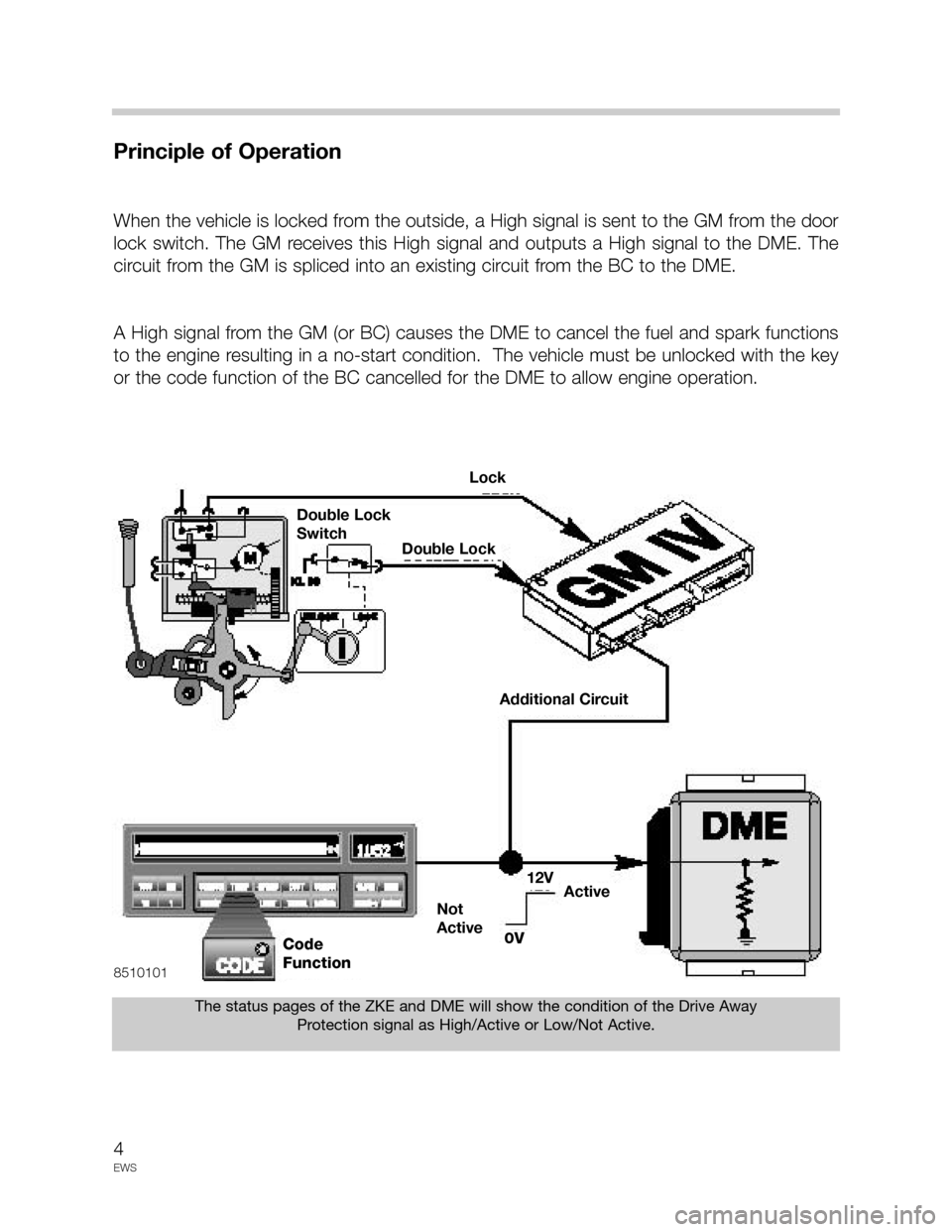
4
EWS
Principle of Operation
When the vehicle is locked from the outside, a High signal is sent to the GM from the door
lock switch. The GM receives this High signal and outputs a High signal to the DME. The
circuit from the GM is spliced into an existing circuit from the BC to the DME.
A High signal from the GM (or BC) causes the DME to cancel the fuel and spark functions
to the engine resulting in a no-start condition. The vehicle must be unlocked with the key
or the code function of the BC cancelled for the DME to allow engine operation.
The status pages of the ZKE and DME will show the condition of the Drive Away
Protection signal as High/Active or Low/Not Active.
8510101
Lock
Double Lock
Double Lock
Switch
Additional Circuit
12VActive
Not
Active
0VCode
Function
Page 8 of 30

8
EWS
EWS II
Starting with 1/95production, all vehicles were equipped with a new EWS system, EWS II.
This change was once again brought about to meet the next level of compliancy with the
European Insurance Commission regulations.
Purpose of The System
Changes to the European Insurance Commission regulations made it necessary to intro-
duce a new theft protection system with greater capabilities and a higher level of security.
The EWS II system operates independent of the mechanical key. The mechanical key only
makes a request of the vehicle starting system. Verification of the key electronically is
required before the starting procedure is initiated.
The system features wireless communication between a programmed EEPROM housed in
the ignition key and the EWS II control module. A key which is properly coded to the EWS
II control module is required before starting operation continues. The EWS II and the DME
control modules are synchronized through an Individual Serial Number (ISN).
The ISN, stored in the EWS II,
must match that of the DME every
time the ignition is switched “ON”
before engine operation is
allowed.
EWS II was installed on E31, E34,
E36, E38 and E39 vehicles.
Major components of the EWS II
system are:
• Key with Transponder
• Ring Antenna
• Transmitter/Receiver Module
• EWS II Control Module
• DME Control Module
8510111
EWS II
Page 9 of 30
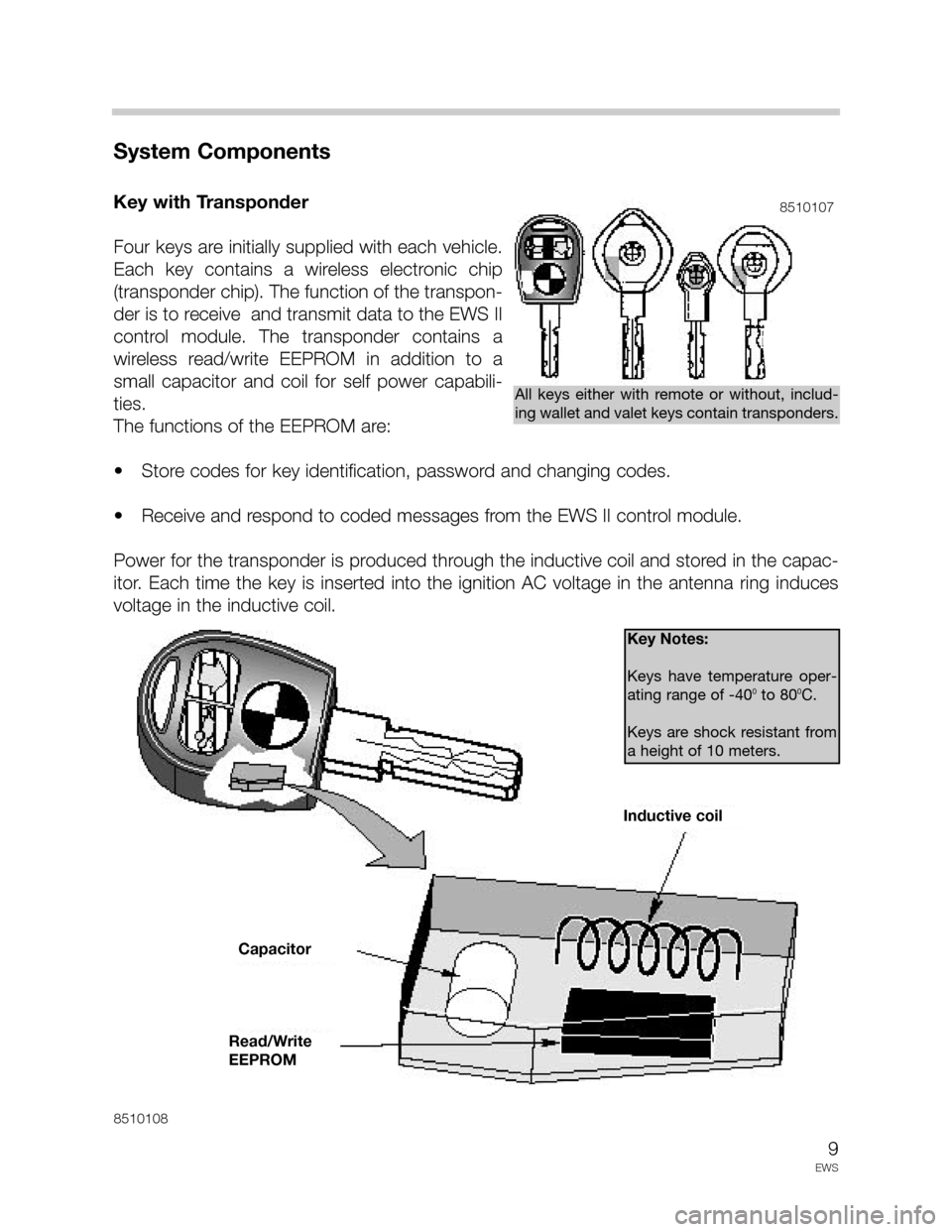
9
EWS
System Components
Key with Transponder
Four keys are initially supplied with each vehicle.
Each key contains a wireless electronic chip
(transponder chip). The function of the transpon-
der is to receive and transmit data to the EWS II
control module. The transponder contains a
wireless read/write EEPROM in addition to a
small capacitor and coil for self power capabili-
ties.
The functions of the EEPROM are:
• Store codes for key identification, password and changing codes.
• Receive and respond to coded messages from the EWS II control module.
Power for the transponder is produced through the inductive coil and stored in the capac-
itor. Each time the key is inserted into the ignition AC voltage in the antenna ring induces
voltage in the inductive coil.
All keys either with remote or without, includ-
ing wallet and valet keys contain transponders.
8510108
8510107
Key Notes:
Keys have temperature oper-
ating range of -40
0to 800C.
Keys are shock resistant from
a height of 10 meters.
Inductive coil
Capacitor
Read/Write
EEPROM
Page 10 of 30
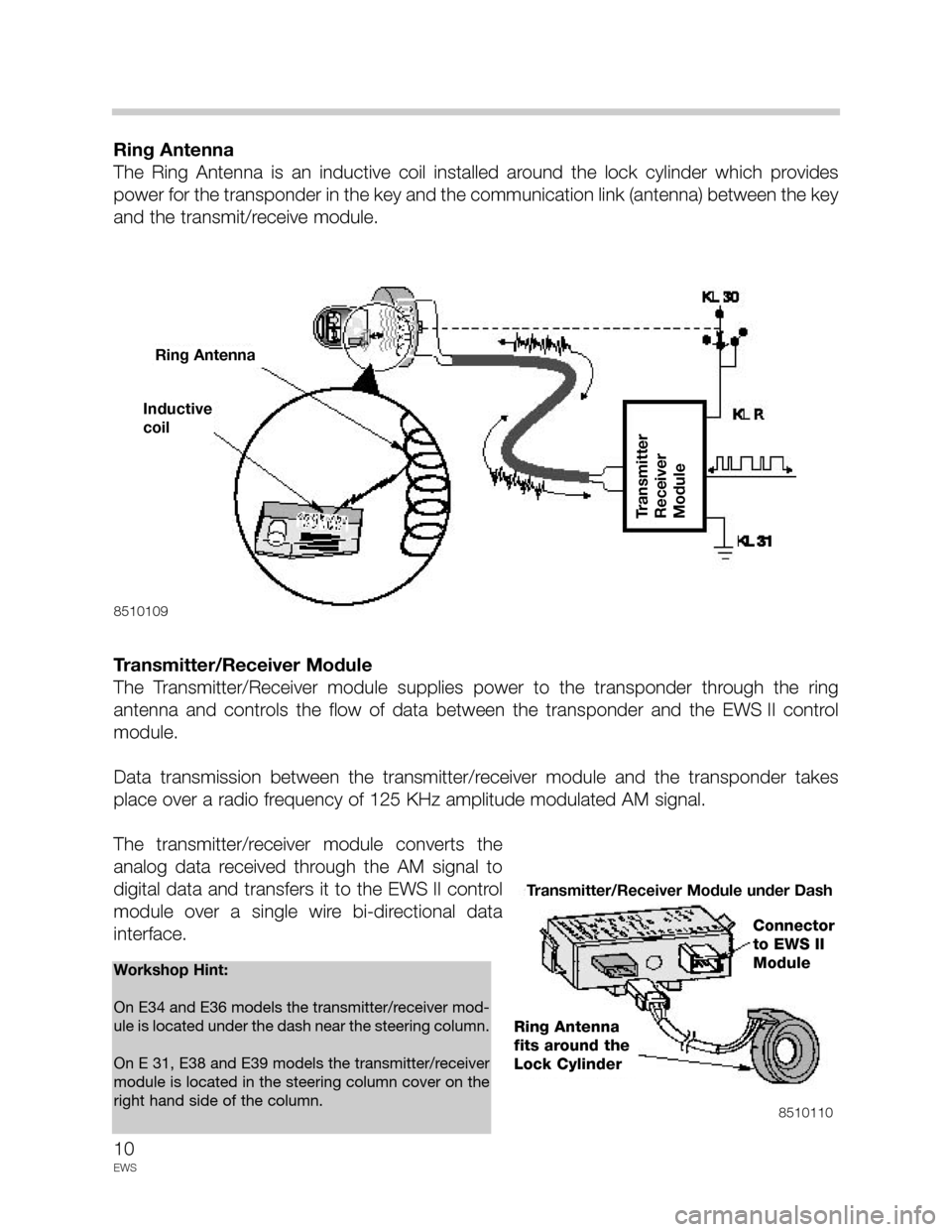
10
EWS
Ring Antenna
The Ring Antenna is an inductive coil installed around the lock cylinder which provides
power for the transponder in the key and the communication link (antenna) between the key
and the transmit/receive module.
Transmitter/Receiver Module
The Transmitter/Receiver module supplies power to the transponder through the ring
antenna and controls the flow of data between the transponder and the EWS II control
module.
Data transmission between the transmitter/receiver module and the transponder takes
place over a radio frequency of 125 KHz amplitude modulated AM signal.
The transmitter/receiver module converts the
analog data received through the AM signal to
digital data and transfers it to the EWS II control
module over a single wire bi-directional data
interface.
8510109
8510110
Workshop Hint:
On E34 and E36 models the transmitter/receiver mod-
ule is located under the dash near the steering column.
On E 31, E38 and E39 models the transmitter/receiver
module is located in the steering column cover on the
right hand side of the column.
Inductive
coil
Ring Antenna
Transmitter
Receiver
Module
Transmitter/Receiver Module under Dash
Connector
to EWS II
Module
Ring Antenna
fits around the
Lock Cylinder
Page 11 of 30

11
EWS
EWS II Control Module
The EWS II Control Module is linked to the BC, GM, DME, Trans Range switch and the
starter for drive away protection operation. The module incorporates an integral starter relay
and stores data and codes for communication with the transponder chip.
The function of the EWS II module is to provide improved drive away protection for the vehi-
cle and it incorporates many features of previous systems:
• Lock out of the starter when the code function of the BC is set.
• Disable injection and ignition through the DME.
• Prevent starter engagement with engine running.
• Recognition of Park/Neutral position with automatic transmission.
New features that have been added:
• Disable injection, ignition and starter operation until a correct key is recognized.
• EWS and DME synchronization through the use of the ISN.
• Release of double lock when a correctly coded key is switched on.
The EWS II control module stores the following data
for the key transponder inter-link:
• Key identification code- up to 10 keys.
• Key password.
• Changing code- up to 10 keys.
Workshop Hint:
On E31, E36, E38 and E39 models the
EWS II control module is located behind
the glove box in the electrical carrier.
On E34 models the module is located on
the drivers side of the vehicle behind the
knee bolster.
8510106
Typical component locations
E36 shown
Page 12 of 30
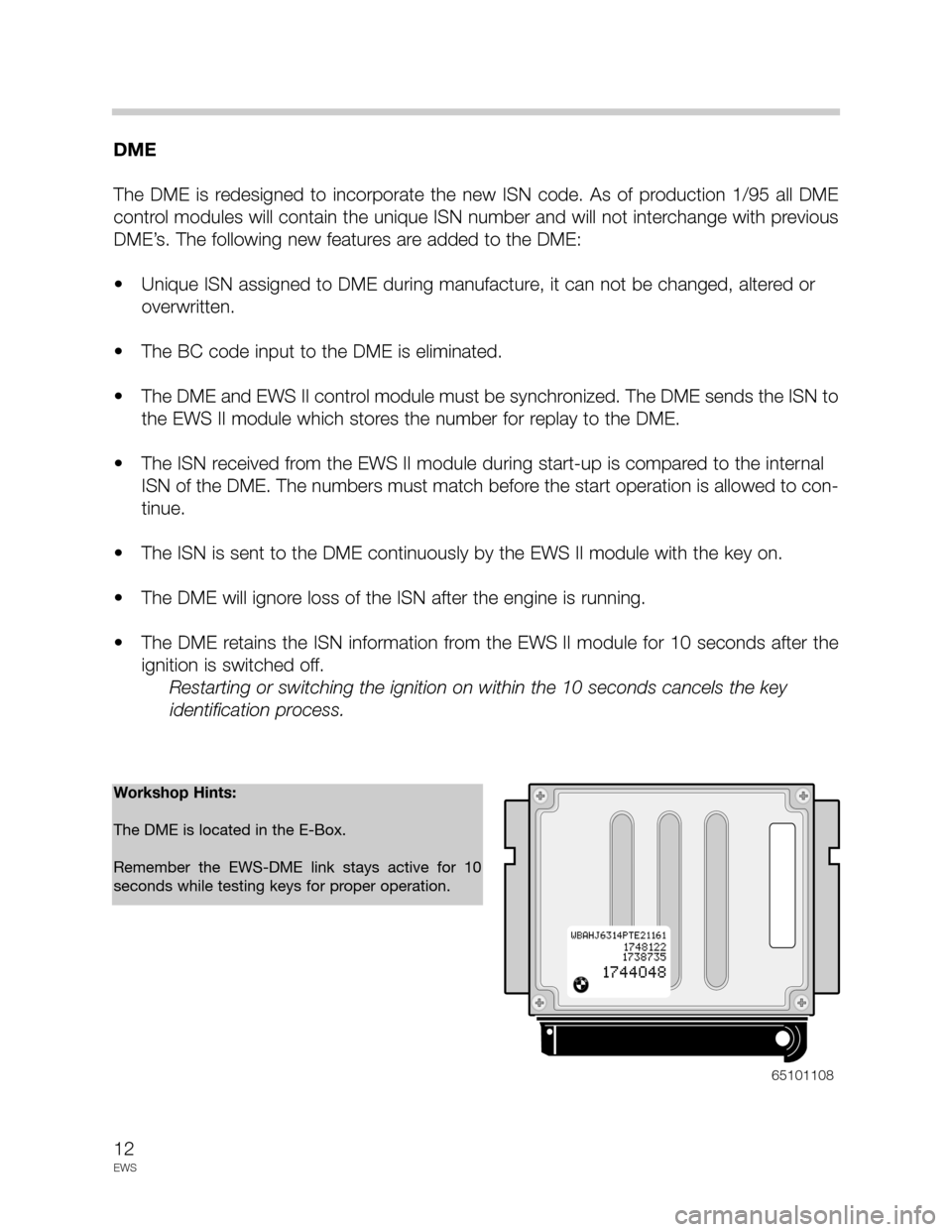
12
EWS
DME
The DME is redesigned to incorporate the new ISN code. As of production 1/95 all DME
control modules will contain the unique ISN number and will not interchange with previous
DME’s. The following new features are added to the DME:
• Unique ISN assigned to DME during manufacture, it can not be changed, altered or
overwritten.
• The BC code input to the DME is eliminated.
• The DME and EWS II control module must be synchronized. The DME sends the ISN to
the EWS II module which stores the number for replay to the DME.
• The ISN received from the EWS II module during start-up is compared to the internal
ISN of the DME. The numbers must match before the start operation is allowed to con-
tinue.
• The ISN is sent to the DME continuously by the EWS II module with the key on.
• The DME will ignore loss of the ISN after the engine is running.
• The DME retains the ISN information from the EWS II module for 10 seconds after the
ignition is switched off.
Restarting or switching the ignition on within the 10 seconds cancels the key
identification process.
Workshop Hints:
The DME is located in the E-Box.
Remember the EWS-DME link stays active for 10
seconds while testing keys for proper operation.
65101108
Page 13 of 30
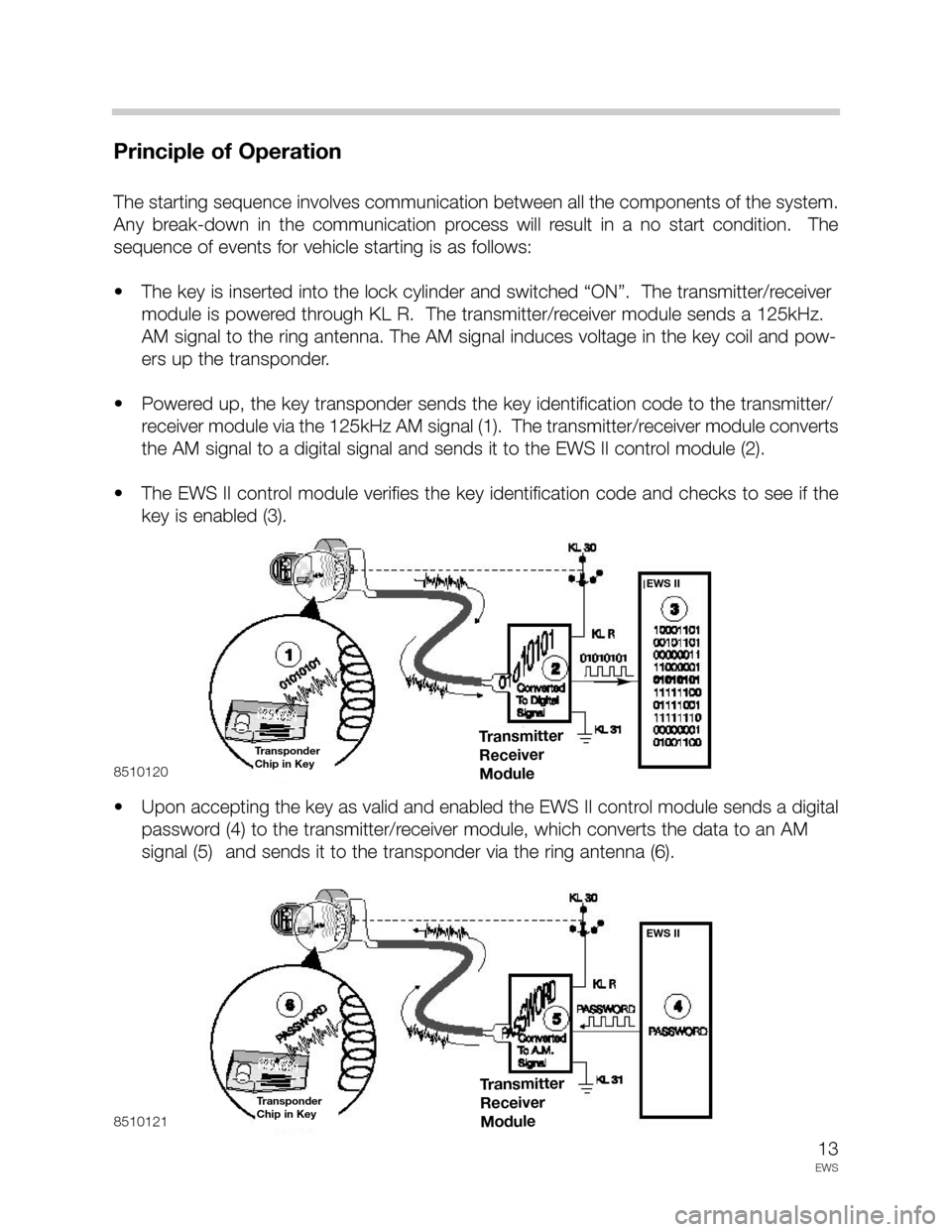
13
EWS
Principle of Operation
The starting sequence involves communication between all the components of the system.
Any break-down in the communication process will result in a no start condition. The
sequence of events for vehicle starting is as follows:
• The key is inserted into the lock cylinder and switched “ON”. The transmitter/receiver
module is powered through KL R. The transmitter/receiver module sends a 125kHz.
AM signal to the ring antenna. The AM signal induces voltage in the key coil and pow-
ers up the transponder.
• Powered up, the key transponder sends the key identification code to the transmitter/
receiver module via the 125kHz AM signal (1). The transmitter/receiver module converts
the AM signal to a digital signal and sends it to the EWS II control module (2).
• The EWS II control module verifies the key identification code and checks to see if the
key is enabled (3).
• Upon accepting the key as valid and enabled the EWS II control module sends a digital
password (4) to the transmitter/receiver module, which converts the data to an AM
signal (5) and sends it to the transponder via the ring antenna (6).
8510120
8510121
Transmitter
Receiver
Module
Transmitter
Receiver
Module
Transponder
Chip in Key
Transponder
Chip in Key
EWS II
EWS II
Page 14 of 30

14
EWS
• If the transponder accepts the password as correct the transponder releases the
changing code (7) to the transmitter/receiver module which converts this AM signal to
digital (8) and sends it to the EWS II module (9).
• If the changing code received by the EWS II module is correct, the status of the BC,
transmission range switch and TD is examined. With correct input status the internal
starter relay is energized and the starter motor begins to operate (10). At the same
time the EWS II module sends the ISN to the DME via the single wire communication
link (11).
• If the ISN code stored in the EWS II module matches that of the DME, the drive away
protection is cancelled and injection and ignition is enabled.
• During the process of sending the ISN to the DME, the EWS II module sends a new
changing code to the transponder through the transmitter/receiver and ring antenna.
The transponder stores the changing code until
the next starting sequence.
8510122
8510124
10
11
Workshop Hints:
The entire process takes place in under 750ms.
If the starter operates, the key has been recognized as
OK and the key requires no further diagnosis. Check
status of ISN in DISplus or MoDic.
Recognition of a valid key by the EWS II module caus-
es it to send an unlock signal to the GM if the vehicle is
in double lock.
Transponder
Chip in KeyTransmitter
Receiver
Module
EWS II
EWS II